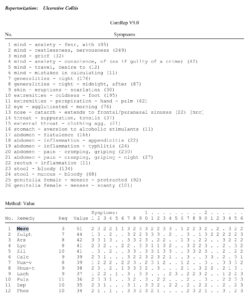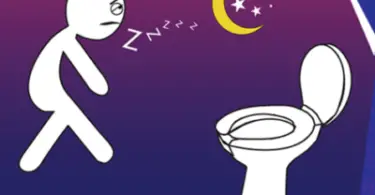A young woman of 26 was suffering from ulcerative colitis, an inflammatory gastrointestinal disease that is considered incurable by conventional medicine and controlled with cortisone. This had been going on for about 1½ years and manifested itself with acute diarrhea, severe night cramps, bloating of the entire abdomen, and bloody stools.
After a colonoscopy, she was diagnosed with ulcerative colitis along with stenosis[1], edema, and severe inflammation in the lower intestine. At night, it was particularly bad with chills and accompanying panic attacks with crying spells, especially after midnight and until the wee hours of the morning. It wasn’t that bad during the day.
The diarrhea consisted of more blood than actual stools. Tea and a hot water bottle would help relieve the cramps. The woman was “very agitated, restless and nervous” and “afraid something bad would happen”.
She had already experienced bloody diarrhea when she was 15 years of age, but it had not yet been as bad as when she came to see me. It was around that time that her father had died of pancreatic cancer.
The diagnosis at the time was ulcerative colitis, but wasn’t treated any further. “I was able to solve it with (healthy) nutrition.” A few years later similar symptoms occurred while on a trip across the US; they were treated with Salofalk. But that time she couldn’t avoid taking cortisone.
Three years earlier, the young woman had experienced a psychotic break and spent three months in a psychiatric ward, then three months in a clinic, and three more months with her family at home. Overall, she had been on psychopharmaceuticals for almost two years.
She was doing fine when she came to see me and had gained a lot of self-confidence, more than ever. She was even able to go on vacation by herself, something she had never dared to do before. During the psychotic episode, a colonoscopy was also performed. It didn’t show any active inflammatory processes, but only scarring.
The patient’s father, a secret alcoholic, had abused her sister, who was about 12 years older, and possibly even “regularly raped”[2] her, with the knowledge and tolerance of her mother.
He had also cheated on her mother in other ways. All that had “completely destroyed” her father image. A few years later at about the age of 16, she too, barely escaped being raped by a stranger.
The young woman was the sixth and youngest child of the family. Originally, she wasn’t wanted by the mother, a fact that she had always made abundantly clear. As a schoolgirl, she had frequently suffered from purulent tonsillitis, which was often accompanied by joint pains.
In addition, purulent conjunctivitis occurred again and again, during which her eyes were always glued shut in the morning. She was given “the usual” vaccinations (smallpox, DPT, polio) and had never reacted abnormally to any of them.
She also suffered from hay fever, which improved about 6 years before seeing me, thanks to autologous blood therapy. She also suffered from sinus infections. The latter were particularly pronounced before and during her psychotic episode and repeatedly appeared with thick yellowish mucus when she had a cold, despite an “outpatient procedure to puncture the sinuses”.
In addition, she was allergic to apples; she would react with a runny nose and itching in the throat. Her skin was quite dry and sometimes flaked off on the fingers. This could have possibly been related to the oils with which she came into constant contact on the job. She couldn’t wear any costume jewelry, such as earrings containing nickel; these would make her pierced ears fester very quickly.
A hearing test had revealed a loss of hearing at high-frequencies. She couldn’t stand tight turtlenecks, didn’t like to wear necklaces, etc. “None of those things at all.”
She had been using an IUD for about 2 years; before that she had been on the pill for a long time, which she had “tolerated well”. However, the time when she stopped taking the pill coincided directly with the period when she suffered her psychotic break and, in my experience, most certainly had something to do with it!
Her periods were very weak and lasted significantly longer than a week. Due to the psychopharmaceuticals she was now on, she didn’t have her period for a year until she was placed on hormones. The rhythm currently matched that of the moon every 28 days; the bleeding itself was light red to very dark and resembled spotting.
She had once had a genital yeast infection with burning, itchy discharge. Her feet were always cold, and when excited, she would get red spots on her neck as well as sweaty hands.
When she was still in school, she used to be unable to “sleep before math classes”; she always did poorly and didn’t get good grades. Overall, she was very sensitive and fearful of another psychotic episode.
In the past, she used to be very withdrawn and kept a lot to herself. “Everyone came to me to tell me their problems.” There were repeated phases of depression between the ages of 15 and 20.
She had also had feelings of guilt all her life. Two years earlier, she had decided to “completely give up alcohol” and hadn’t touched anything like it since. When she came to see me, vacation and travel were the highlights of her life.
The family medical history showed a frequent occurrence of scarlet fever; all five siblings had had the childhood disease, including the twins. There were also abscesses in sweat glands and appendix as well as recurrent purulent tonsillitis.
The mother had one stillborn child and another child died at the age of 2 months of sudden infant death syndrome. In addition, the mother had undergone varicose vein surgery and a total hysterectomy.
The father suffered from pancreatic cancer and, like the mother, was diabetic. The extended family medical history also included gall bladder surgery, jaundice (hepatitis A and B), psoriasis, depression, and suicide attempts.
A dominant syphilitic disease against a latent, sycotic background. The main symptoms used to choose the chronic anti-syphilitic remedy were:
- anxiety attacks with restlessness
- nightly aggravation
- inflammatory gastrointestinal symptoms including all of the accompanying symptoms as well as the family history of appendicitis (incl. abscesses)
- emotional distress (“grief”) due to the experiences involving the father and because of the original rejection by the mother
- pronounced desire to travel
- predisposition within the family with regard to scarlet fever, a syphilitic childhood disease
- past psychotic episodes
- excessively long periods
- tendency to sinus infections
- the decision to become a teetotaler
- as well as the lifelong feelings of guilt.
Remedy: Mercurius solubilis LM18, 5 drops on a teaspoonful of water,
every 2 days in the morning. Cortisone treatment was to be maintained until a significant impact was observed.
After six weeks, the patient reported that she was doing quite well. She had even stopped taking the cortisone on her own five days earlier. But now she had an acute throat infection with severe difficulty swallowing, especially at night.
In addition, she had a headache, runny nose (fluid, watery, postnasal drip), and an earache. The lymph nodes in her neck were swollen; her head was red-hot, almost as if glowing. In addition, she was also very thirsty for water and lukewarm tea, both of which she consumed in many small sips.
She craved fresh air, but had to dress very warmly, or she would freeze. Arsenicum album LM6, another anti-syphilitic remedy, was administered as an acute remedy to get her back on her feet very quickly.
Later there was another serious sinus infection that was alleviated with Kali bichromicum 6X. According to Hering’s Law, both were completely normal and even welcome events as part a rewinding process.
Then I didn’t hear from her for a long time. After about five months, she wrote to me in the process of putting together a set of remedies for use at home and while on the road.
Among other details, her detailed progress report said: “By the way, wasn’t there something about the intestine at some point? In any case, I no longer have any problems and am very happy about it.”
Another three months later, her condition was still the same; this part of the treatment could then be considered complete. About another year later, we did an anti-sycotic treatment after she had come back from abroad.
Her intestine, however, never again caused any issues (at that point, more than 12 years had passed), so that ulcerative colitis, which was otherwise considered to be incurable, could then be regarded as cured.
Bibliography
- Allen, J. H., The Chronic Miasms, 1921, Reprint Edition 2006, B. Jain Publishers Pvt. Ltd., New Dehli
- Grätz, Dr. Joachim-F., Gentle Medicine – The True Causes of Disease, Healing, and Health, 2021, Balboa Press, Bloomington, USA
- Grätz, Joachim-F., Klassische Homöopathie für die junge Familie – Kinderwunsch, Schwangerschaftsbegleitung und Geburt, Kleinkindbetreuung, Entwicklungsstörungen und Behinderungen, natürliche Entwicklung
(Classical Homeopathy for the Young Family – Desire for Children, Pregnancy and Childbirth, Toddler Care, Developmental Disabilities and Impairments, Natural Development),
2 Volumes, 3rd edition 2013/2016, Tisani Verlag, Oberhausen i. Obb. - Grätz, Joachim-F., Questionnaire for your homoeopathic anti–miasmatic treatment, 2011, 32 pages, Tisani Verlag, Oberhausen i. Obb., Germany
[1] Stenosis: congenital or acquired narrowing of hollow organs or vessels.
[2] Unfortunately, this is not uncommon and emerges frequently with chronic medical histories and family medical histories; especially if the venereal miasms are quite pronounced and complicated by other miasms.







why not all cases of ulcerative colitis are not cured by homeopath ? Is autoimmune cause making obstacle to cure?
Hi Dr. Deepak Chormale,
Thanks for your important question.
Unfortunately, I can’t say that either.
This is probably due to the understanding of the five chronic miasms and their exact application. And of course, this also depends on a good medical history, which is not only based on the acute symptoms. This sort of anamnesis includes a detailed life medical history, a pregnancy medical history of the biological mother as well as a medical history of the blood relatiives.
In any case, autoimmune diseases are not an obstacle to healing, because these can also be treated homeopathically; with the chronic approach, i.e. anti-miasmatic. Autoimmune diseases have only been around since vaccinations. In pure nature it does not exist that the body’s own defense cells are directed against the body’s own tissue.
With the warmest greetings from far away Germany
Joachim-F. Grätz